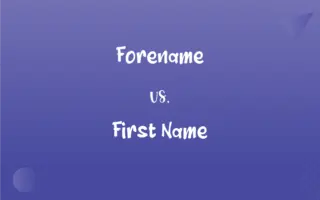Dark Ages vs. Medieval Ages: What's the Difference?
Edited by Aimie Carlson || By Harlon Moss || Published on January 17, 2024
Dark Ages historically referred to the early Middle Ages in Europe, a period seen as lacking significant cultural and scientific achievements. Medieval Ages is broader term for the period in Europe from the 5th to the late 15th century.

Key Differences
The Dark Ages commonly refer to the period following the fall of the Western Roman Empire, marked by social, economic, and cultural decline. In contrast, the Medieval Ages encompass this period but also extend to the Renaissance, showcasing a gradual but significant evolution in various aspects of society.
Culturally, the Dark Ages were seen as a period of backwardness, with limited advancements in the arts or sciences. The Medieval Ages, however, witnessed the flourishing of Gothic architecture, the establishment of universities, and significant strides in literature and philosophy.
Politically, the Dark Ages were characterized by the fragmentation of the Roman Empire into smaller, often warring, kingdoms. During the Medieval Ages, these kingdoms began to consolidate, leading to the formation of the modern nation-states and the evolution of feudalism.
In terms of social structure, the Dark Ages saw the rise of feudalism and a predominantly agrarian society with limited mobility. The later Medieval Ages experienced more social mobility, partly due to the growth of towns and the middle class.
The Dark Ages are often associated with the spread of Christianity and the establishment of monasticism, while the later Medieval Ages saw the growth of scholasticism, the Crusades, and significant religious reforms and conflicts.
ADVERTISEMENT
Comparison Chart
Time Period
Roughly 5th to 10th century
5th to 15th century
Cultural Development
Minimal, with a focus on survival
Significant, including Gothic architecture
Political Structure
Fragmented kingdoms, local lords
More centralized states, rise of monarchies
Economic Focus
Agrarian, subsistence farming
Diversification, trade growth
Religious Influence
Christianity spreads, monasticism
Scholasticism, religious reforms
ADVERTISEMENT
Dark Ages and Medieval Ages Definitions
Dark Ages
A time marked by the absence of recorded historical detail.
Many manuscripts were lost during the Dark Ages, leaving gaps in historical knowledge.
Medieval Ages
A period marked by the transition from the Roman Empire to the Renaissance.
The Medieval Ages bridged the classical world and the modern era.
Dark Ages
An era characterized by the prevalence of superstition over scientific understanding.
The Dark Ages were times when myths often overpowered scientific reasoning.
Medieval Ages
The historical period in Europe between the 5th and 15th centuries, known for feudalism and the rise of kingdoms.
The Medieval Ages were marked by the construction of iconic castles and cathedrals.
Dark Ages
A phase of social and political disorder and disintegration.
The Dark Ages witnessed the collapse of centralized Roman authority.
Medieval Ages
An era characterized by significant developments in art, architecture, and learning.
The Medieval Ages saw the emergence of Gothic architecture and the first universities.
Dark Ages
The early part of the Medieval Ages, often seen as lacking in cultural and scholarly activity.
Art and literature saw limited development during the Dark Ages compared to later periods.
Medieval Ages
An age noted for its hierarchical social structure and feudal system.
Feudalism defined the social and political landscape of the Medieval Ages.
Dark Ages
A period of cultural and economic decline in Europe following the fall of the Roman Empire.
The Dark Ages saw Europe transitioning from Roman rule to fragmented kingdoms.
Medieval Ages
A time of major religious movements, including the Crusades and scholasticism.
The Medieval Ages were defined by the Crusades, which had a lasting impact on Europe and the Middle East.
FAQs
What is the Dark Ages?
A period in European history marked by cultural and economic decline after the fall of Rome.
What is the time span of the Medieval Ages?
Roughly from the 5th to the late 15th century.
What are the main features of the Medieval Ages?
Feudalism, Gothic architecture, the Crusades, and the growth of towns.
What is the Medieval Ages?
A historical era in Europe from the 5th to 15th centuries, known for significant cultural and political developments.
What caused the Dark Ages?
The fall of the Roman Empire and subsequent social and economic disruptions.
How did religion influence the Medieval Ages?
Religion shaped every aspect of life, from politics to education.
How long did the Dark Ages last?
Approximately from the 5th to the 10th century.
How did the Medieval Ages contribute to modern society?
It laid the foundations for modern statehood, legal systems, and cultural movements.
Were the Dark Ages really dark?
Historically, it was a period of decline, but the term is now seen as oversimplified.
Did the Dark Ages lack cultural achievements?
While less prominent, there were still cultural developments, particularly in monastic settings.
What ended the Medieval Ages?
The onset of the Renaissance and the Age of Discovery.
How was art in the Dark Ages?
It was mostly religious and less sophisticated than later Medieval art.
Did the Dark Ages have a government structure?
It was mostly localized and feudal, with weak central authority.
How did warfare evolve in the Medieval Ages?
It saw the introduction of new tactics and technology, including castles and armored cavalry.
Were the Dark Ages devoid of scientific progress?
Progress was slow, but not absent, with some advancements in areas like agriculture.
How did trade change in the Medieval Ages?
It expanded significantly, leading to the growth of a merchant class.
Was Christianity important in the Dark Ages?
Yes, it spread widely and played a crucial role in society.
What role did knights play in the Medieval Ages?
Knights were central to the feudal system and military conflicts.
What was education like in the Medieval Ages?
It evolved significantly, leading to the establishment of universities.
What languages were spoken in the Dark Ages?
Various Germanic and Romance languages, evolving from Latin.
About Author
Written by
Harlon MossHarlon is a seasoned quality moderator and accomplished content writer for Difference Wiki. An alumnus of the prestigious University of California, he earned his degree in Computer Science. Leveraging his academic background, Harlon brings a meticulous and informed perspective to his work, ensuring content accuracy and excellence.
Edited by
Aimie CarlsonAimie Carlson, holding a master's degree in English literature, is a fervent English language enthusiast. She lends her writing talents to Difference Wiki, a prominent website that specializes in comparisons, offering readers insightful analyses that both captivate and inform.







































































